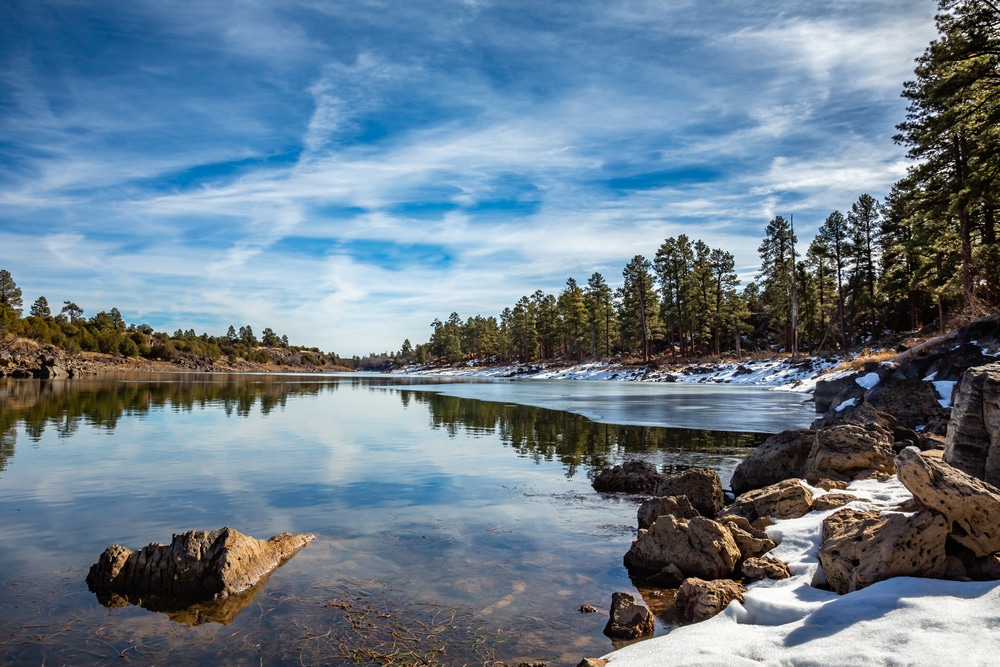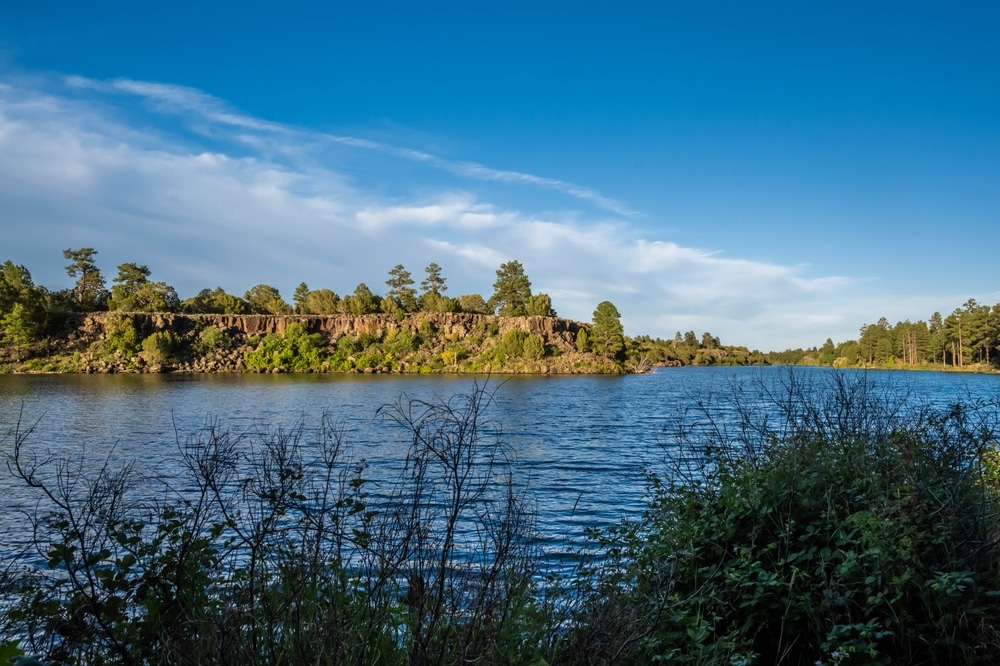Nestled within the world’s largest contiguous belt of ponderosa pine forest, Fool Hollow Lake Recreation Area stands as a testament to successful interagency cooperation and natural resource management in Arizona. Located just two miles north of Show Low in east-central Arizona, this 800-acre recreation area encompasses a serene 149-acre lake at a cool elevation of 6,300 feet. The park’s unique name comes with a touch of historical humor—in 1885, Thomas Jefferson Adair moved into the area with intentions of farming the rocky canyon. Local residents joked that “only a fool would try to farm the place,” and the name stuck. The tiny town of Adair was eventually covered by the lake when a dam was constructed in 1957.

Fool Hollow Lake Recreation Area officially opened to the public in 1994 as the result of a remarkable partnership between the U.S. Forest Service, Arizona State Parks, Arizona Game and Fish Department, and the city of Show Low, with additional support from Arizona Public Service and McCarty Construction Company. This collaboration transformed what had become a problem area with unrestricted uses and environmental concerns into one of Arizona’s premier outdoor recreation destinations.
The recreation area offers visitors a chance to experience the beauty of Arizona’s high country with its relatively flat basaltic plateau, broken by Show Low Creek and Fool Hollow Wash. With year-round camping, fishing, picnicking, boating, and wildlife viewing opportunities, Fool Hollow has become a popular destination for outdoor enthusiasts of all ages. Its significance to Arizona’s park system cannot be overstated, as it represents one of the few high-elevation, water-based recreation areas in the northern part of the state, offering respite from the desert heat that dominates much of Arizona.

The iconic London Bridge stands as Lake Havasu City’s most famous landmark. Purchased from the City of London in 1968 by Robert McCulloch for $2.46 million, the bridge was meticulously disassembled, transported, and reconstructed over a man-made channel. Today, visitors can walk across this historic structure, explore its English Village shopping area, and learn about its fascinating relocation through interpretive displays and guided tours.

The crystal-clear waters of Lake Havasu offer premier opportunities for swimming, water skiing, wakeboarding, and paddleboarding. The lake’s 450 miles of shoreline provide numerous beaches and coves for water activities. Temperatures remain warm enough for comfortable swimming from spring through fall, with summer water temperatures often reaching the mid-80s Fahrenheit.

The lake accommodates non-motorized watercraft and boats with electric motors only, creating a peaceful environment free from the noise and wakes of gas engines. This makes Fool Hollow Lake perfect for kayaking, canoeing, paddleboarding, and small fishing boats. Two boat ramps provide convenient water access, and the calm waters make it ideal for beginners. Boat rentals are available seasonally at the park store.

Fool Hollow Lake is renowned for its excellent fishing opportunities throughout the year. The 150-acre lake is regularly stocked with rainbow trout, with additional populations of largemouth bass, smallmouth bass, channel catfish, and sunfish. Anglers can fish from two accessible fishing piers, numerous shoreline access points, or boats (electric motors only). Winter ice fishing is popular when conditions permit, offering a unique seasonal experience in Arizona’s high country.

Several well-maintained trails wind through the recreation area, showcasing diverse landscapes and offering scenic lake views. The 1.5-mile Lakeshore Trail follows the water’s edge with multiple observation points, while the Interpretive Forest Trail educates visitors about local ecology and forest management practices. Connected trail systems extend into the surrounding Apache-Sitgreaves National Forest for those seeking longer hiking adventures.
Located at 6,300 feet elevation with minimal light pollution, Fool Hollow offers exceptional stargazing opportunities. The clear mountain air and open areas around the lake create ideal conditions for observing celestial objects. The park occasionally hosts astronomy programs with telescopes and guided constellation tours, taking advantage of Arizona’s renowned dark skies.

The diverse habitats within Fool Hollow Lake Recreation Area support over 100 bird species, making it a premier destination for birding enthusiasts. The combination of lake, wetlands, ponderosa pine forest, and meadows creates varied ecological niches. Bald eagles, ospreys, great blue herons, and numerous waterfowl are commonly spotted, particularly during spring and fall migrations. The Meadow Trail features interpretive signage about local bird species and their habitats.

Fool Hollow offers 123 developed campsites across multiple campgrounds with varying amenities. Sites range from standard tent spaces to full RV hookups with electricity, water, and sewer connections. Each campsite includes a fire ring, picnic table, and grill, with modern restrooms and hot showers nearby. The lakeside campsites provide particularly scenic settings with direct water views and easy access to shoreline trails.

Multiple day-use areas around Fool Hollow Lake provide picnic tables, grills, and shade ramadas with spectacular lake views. These facilities are strategically placed to take advantage of scenic vistas and natural shade from ponderosa pines. Group picnic areas with larger capacity ramadas are available by reservation for family gatherings and special events.
Water activities form the heart of recreation at Fool Hollow Lake, with options for visitors of all ages and interests. The lake’s peaceful waters are perfect for kayaking, canoeing, and paddleboarding, offering a serene way to explore the shoreline and observe wildlife. During summer months, a concessionaire operates at the park, renting kayaks, canoes, and paddleboards to visitors. Motorized boating is permitted, though a no-wake policy helps maintain the tranquil atmosphere that makes Fool Hollow Lake special.
Swimming is allowed from boats or along the shoreline, though there is no designated swimming beach. On hot summer days, the cool mountain lake provides welcome relief from the heat, though water temperatures remain refreshingly brisk even in mid-summer due to the park’s elevation.
Fishing is a major draw at Fool Hollow Lake, with abundant opportunities for anglers of all skill levels. The lake supports a diverse fishery including rainbow trout (stocked regularly from mid-May through September), largemouth and smallmouth bass, black crappie, green sunfish, channel catfish, walleye, and northern pike. Five fishing platforms around the lake provide easy access for shore fishing, while anglers with boats can reach deeper waters where larger fish often lurk. Two fish cleaning stations in the park help anglers prepare their catch. Remember that a valid Arizona fishing license is required for anglers fourteen years and older.
For those preferring to stay on dry land, Fool Hollow offers several hiking trails that wind through the ponderosa forest and around portions of the lake. These trails are generally easy to moderate in difficulty, making them accessible to most visitors. The shoreline paths provide excellent views of the lake and opportunities for wildlife spotting, while forest trails immerse hikers in the peaceful pine environment. Though not extensive enough for serious backpacking, the trails are perfect for day hikes and nature walks.
Photography enthusiasts will find endless inspiration at Fool Hollow Lake, from sweeping vistas of the lake surrounded by pines to close-up shots of wildlife and seasonal wildflowers. The soft morning light reflecting off the lake, dramatic summer monsoon storms, colorful sunsets, and winter snow scenes all offer unique photographic opportunities throughout the year.
Stargazing is exceptional due to the park’s relatively remote location and minimal light pollution. The clear mountain air and high elevation provide excellent conditions for observing the night sky. During summer months, educational programs sometimes include night sky viewing sessions, introducing visitors to the wonders of astronomy.

| Category | Details |
|---|---|
| Location | Show Low, Arizona, USA |
| Area | 800 acres (324 hectares) |
| Elevation | 6,300 feet (1,920 m) |
| Established | 1994 as an Arizona State Park |
| Lake Size | 150 acres (61 hectares) |
| Lake Type | Manmade reservoir |
| Name Origin | Named after Thomas Jefferson Adair, who homesteaded the area in 1885 and was called a “fool” for trying to farm in the rocky meadow |
| Management | Cooperative management between Arizona State Parks, US Forest Service, Arizona Game & Fish Department, and City of Show Low |
| Facilities | 123 campsites with water, electric, and sewer hookups; group areas, picnic ramadas |
| Recreation | Fishing, boating (electric motors only or up to 8 HP gas), kayaking, hiking, bird watching |
| Trails | 3-mile (4.8 km) hiking and nature trail around the lake |
| Fish Species | Rainbow trout, brown trout, largemouth bass, crappie, sunfish, channel catfish |
| Wildlife | Elk, deer, pronghorn, bald eagles, osprey, herons, waterfowl |
| Plant Life | Ponderosa pine, juniper, blue spruce, wildflowers |
| Climate | Four seasons with snow in winter, cool mountain summers |
| Best Time to Visit | Late spring through early fall (May-October) |
| Winter Activities | Ice fishing when lake freezes (typically December-February) |
| Unique Features | ADA-accessible fishing docks, nature trails, and bird viewing areas |
| Distance from Phoenix | Approximately 180 miles (290 km) |
| Nearby Attractions | White Mountains, Mogollon Rim, Show Low Lake, Petrified Forest National Park |
Fool Hollow Lake is the centerpiece of the recreation area, covering 149 surface acres with an average depth of 23 feet. The lake was created in 1957 when the Arizona Game and Fish Department, with federal assistance, constructed a dam at the confluence of Show Low Creek and Fool Hollow Wash. This man-made body of water is surrounded by National Forest lands and provides a crucial water resource in an otherwise arid region.
The lake’s creation was primarily for water-oriented outdoor recreation, but it also serves as a valuable habitat for wildlife and provides fishing opportunities for visitors. The shoreline extends for several miles, offering ample space for fishing, wildlife viewing, and peaceful lakeside strolls. The lake’s water levels can fluctuate seasonally, with drought conditions occasionally affecting water levels, particularly in drier years.
The surrounding landscape is characterized by a relatively flat basaltic plateau, typical of the geology found along Arizona’s Mogollon Rim. This plateau is broken by Show Low Creek and Fool Hollow Wash, which create natural drainage patterns through the recreation area. The basaltic rock foundations are remnants of ancient volcanic activity in the region, contributing to the unique terrain that visitors can explore.
The park sits within the Show Low Creek watershed, which is part of the larger Little Colorado River Basin. This watershed is crucial for the region’s ecology, providing water resources for both wildlife and human communities in east-central Arizona. The park’s location at 6,300 feet in elevation places it in a transition zone between the higher Colorado Plateau to the north and the lower desert regions to the south, creating an interesting ecological crossroads.
Fool Hollow Lake Recreation Area sits within the world’s largest contiguous ponderosa pine forest, providing a unique ecological setting that supports diverse plant and animal communities. The dominant tree species is ponderosa pine, with some specimens reaching heights of 100 feet or more. These towering pines create a peaceful, shaded environment throughout much of the park. Interspersed among the ponderosas are juniper and pinyon pine, adding to the forest’s diversity and providing additional food sources for wildlife.
The understory vegetation includes a variety of native grasses, shrubs, and wildflowers that change with the seasons. Spring and summer bring colorful blooms to the forest floor, while autumn transforms the landscape with golden hues as deciduous plants prepare for winter. The lake’s shoreline hosts water-loving plants that provide crucial habitat for aquatic and semi-aquatic animals.
Wildlife viewing opportunities abound at Fool Hollow Lake. Mammals commonly spotted include Abert’s squirrels with their distinctive tufted ears, rock squirrels, gophers, raccoons, and beavers working diligently along the shoreline. Lucky visitors might glimpse larger mammals such as mule deer, elk, bobcats, and coyotes moving through the forest, especially during early morning or evening hours. The occasional black bear might make an appearance in the surrounding forest areas, though they generally avoid human interaction.
Birdwatching is particularly rewarding at Fool Hollow Lake, with numerous species attracted to the water and surrounding forest habitat. Bald eagles can often be seen perched on snags around the lake, while ospreys dive for fish in the clear waters. The park is home to Steller’s jays, lesser goldfinches, several species of bluebirds, acorn woodpeckers, nuthatches, and red-shafted flickers. Waterfowl are plentiful, with various duck species including cinnamon teal, ruddy ducks, and pintails frequenting the lake. Great blue herons stalk the shallows, while songbirds fill the forest with melody.
The lake itself supports a diverse fish population, creating a complex aquatic ecosystem. Rainbow trout are stocked regularly by the Arizona Game and Fish Department, while largemouth and smallmouth bass, walleye, northern pike, and various panfish reproduce naturally in the lake. This aquatic diversity not only provides excellent fishing opportunities but also supports the bird and mammal species that depend on the lake for food and habitat.
Seasonal ecological changes are pronounced at Fool Hollow Lake. Spring brings migratory birds, summer sees the forest at its most lush and active, fall offers spectacular color changes and wildlife preparing for winter, and the winter months transform the landscape with occasional snow, creating a peaceful alpine setting that contrasts dramatically with Arizona’s desert regions.
Camping at Fool Hollow Lake Recreation Area provides one of the most enjoyable ways to fully experience this mountain oasis. The park features multiple camping loops winding through the ponderosa pine forest, with many sites offering views of the lake and surrounding woodland. There are 123 total campsites available, divided between non-hookup sites and RV sites with utilities.
For tent campers and those seeking a more rustic experience, the park offers 31 non-hookup sites with concrete pads, fire rings, and picnic tables. These sites can accommodate a maximum of two vehicles and six adults per site (12 people total) and provide access to modern restrooms with hot showers. The tent sites are thoughtfully placed to maximize privacy while maintaining convenient access to facilities.
RV enthusiasts will appreciate the 92 sites equipped with electrical hookups (30-amp service, with some 50-amp connections available). These sites can accommodate rigs up to 40 feet in length, with water available at all sites. The Mallard and Redhead Loops offer the added convenience of sewer connections for full hookups. Like the tent sites, RV sites include fire rings and picnic tables, with a maximum of two vehicles and six adults permitted per site.
All campsites require reservations, which can be made up to one year in advance through the Arizona State Parks reservation system. Due to the park’s popularity, especially during summer months and holidays, reservations are strongly recommended and often essential. Campsite fees range from $25 to $35 per night, depending on the level of hookups provided.
A dump station is available for registered campers from May 1 through October 15, adding to the convenience for RV travelers. The campground maintains quiet hours to ensure all visitors can enjoy the peaceful setting, and generators are not permitted at any time within the recreation area.
While Fool Hollow Lake Recreation Area does not offer cabins or permanent lodging structures within the park, the nearby town of Show Low (just two miles away) provides a variety of accommodation options including hotels, motels, bed and breakfasts, and vacation rentals. This proximity allows visitors who prefer not to camp the opportunity to enjoy the park’s amenities as day users while returning to more conventional lodging in the evening.
For those seeking alternative camping experiences in the area, several other campgrounds exist within a short drive, including Show Low Lake Campground approximately 10 miles away, which offers 75 additional campsites for tents, trailers, and RVs.
Fool Hollow Lake Recreation Area operates year-round, though services and amenities may vary seasonally. The park entrance gate opens at 5:00 a.m. and closes at 8:30 p.m. daily. Camping guests arriving after the gate closes must contact the park by 4:00 p.m. with their reservation confirmation number to receive the entrance gate code.
Entrance fees for day use are as follows: $10 for a vehicle with one person, $20 for a vehicle with 2-4 people, and $5 for individuals arriving by bicycle. These fees help maintain the park’s facilities and support ongoing conservation efforts.
The best time to visit Fool Hollow Lake depends largely on your preferred activities and tolerance for different weather conditions. Summer (June through August) offers the warmest temperatures, with daytime highs typically in the 80s and lows in the 50s-60s. This is the busiest season, ideal for water activities and camping. Fall (September through October) brings cooler temperatures and spectacular color changes in the deciduous vegetation, along with smaller crowds. Winter (November through February) can be quite cold, with daytime temperatures ranging from the mid-40s to low 50s and nighttime temperatures frequently dropping below freezing. Snow is common during winter months, creating a beautiful alpine setting. Spring (March through May) sees gradually warming temperatures and the emergence of wildflowers, though the weather can be unpredictable.
Weather considerations are important when planning your visit. Summer afternoons often bring monsoon thunderstorms, particularly in July and August. These typically develop in the afternoon and pass quickly but can bring heavy rain, lightning, and occasionally hail. Winter visitors should prepare for snow and icy conditions, especially on roads and hiking trails. Spring and fall can experience significant temperature fluctuations, so layered clothing is recommended.
For visitors with mobility challenges, Fool Hollow Lake Recreation Area offers accessible facilities including designated campsites, restrooms, fishing platforms, and picnic areas. The visitor center and most day-use areas are wheelchair accessible, though some hiking trails may present challenges due to terrain.
Pets are welcome at Fool Hollow Lake Recreation Area but must be kept on leashes no longer than six feet at all times. Pet owners are responsible for cleaning up after their animals and ensuring they do not disturb wildlife or other visitors. Pets may not be left unattended at campsites or in vehicles.
Cell phone service is generally available throughout the park, though coverage may vary depending on your service provider. Wi-Fi is not provided in the campgrounds or day-use areas, allowing visitors to disconnect and fully enjoy the natural setting.
The visitor center at Fool Hollow Lake Recreation Area serves as the hub for information and services, located conveniently at the park entrance. Here, visitors can obtain maps, learn about park regulations, and get advice on activities and wildlife viewing opportunities. The center also offers a small selection of souvenirs, park memorabilia, and basic camping supplies. Staffed by knowledgeable rangers and volunteers, the visitor center is the perfect first stop upon arriving at the park.
Restroom facilities are well-maintained and strategically placed throughout the park. The campground areas feature modern restrooms with flush toilets and hot showers, while day-use areas provide clean restroom facilities for visitors. Regular maintenance ensures these facilities remain in excellent condition even during busy periods.
For day visitors, Fool Hollow Lake Recreation Area offers five large group picnic ramadas that can be reserved for gatherings. Each ramada includes picnic tables, a large charcoal grill (use contingent on fire restrictions), a serving table, and 15-amp electrical service. Additional amenities at the ramadas include horseshoe pits and nearby restrooms. Smaller picnic areas with tables are scattered throughout the park, providing ample options for outdoor dining.
Boating enthusiasts will appreciate the two boat ramps—one on the east side and one on the west side of the lake—providing convenient water access. Though temporarily affected by construction at times, these well-maintained ramps accommodate various watercraft sizes. The modest size of the lake and no-wake restrictions create a peaceful boating environment ideal for fishing and relaxed exploration.
Children will enjoy the two playgrounds centrally located in the day-use area, offering a dedicated space for younger visitors to play safely. These modern playground facilities provide entertainment for families while adults prepare meals or relax at nearby picnic areas.
For anglers, two fish cleaning stations help prepare the day’s catch, while five fishing platforms around the lake provide stable, accessible locations for shore fishing, including options for visitors with mobility challenges.
During the summer months (May through August), a concession operated by JT Wildlife Outdoors offers boat, canoe, kayak, and mountain bike rentals, enhancing recreation options for visitors who don’t bring their own equipment. This lakeside concession also sells limited fishing supplies, snacks, ice, and firewood, adding convenience for campers and day visitors alike.
The park’s facilities are designed to blend with the natural environment, using materials and colors that complement rather than intrude upon the forest setting. Regular maintenance and updates ensure that amenities remain functional and appealing, supporting the park’s reputation as one of Arizona’s premier outdoor destinations.
The area surrounding Fool Hollow Lake Recreation Area offers abundant opportunities for extending your White Mountains adventure. Within a short drive, visitors can access numerous additional recreation sites and attractions that complement the Fool Hollow experience.
Just a few miles from Fool Hollow, the Sipes White Mountain Wildlife Area provides another excellent opportunity for wildlife viewing and outdoor recreation. Visitors are encouraged to visit the center first to enhance their wildlife viewing experience, then explore the grounds via four trails leading to wetlands, meadows, and old homesteads. The Pintail Wetlands Nature Trail guides hikers around Pintail Lake, where numerous water birds can be observed, including cinnamon teal, ruddy duck, gadwall, bufflehead, American wigeon, and pintail.
Approximately 30 miles east of Show Low, Lyman Lake State Park offers another water-based recreation opportunity. Created by damming the Little Colorado River, this 1,200-acre park encompasses the shoreline of a 1,500-acre reservoir at an elevation of 6,000 feet. Fed by snowmelt from Mount Baldy and Escudilla Mountain (the second and third highest mountains in Arizona), Lyman Lake provides additional opportunities for boating, fishing, and camping.
The surrounding Apache-Sitgreaves National Forest, which encompasses over two million acres of mountain country in east-central Arizona, offers extensive recreation opportunities. From the Mogollon Rim’s 7,600-foot elevation, vista points provide inspiring views of the lowlands to the south. The Rim extends two hundred miles from Flagstaff into western New Mexico and features numerous hiking and mountain biking trails, fishing streams, and scenic drives.
The nearby White Mountain Trail System presents a series of multi-use, major loop trails and connector trails ranging from the community of Vernon on the east to the communities of Clay Springs and Linden in the west. These trails are popular with hikers, mountain bikers, and equestrians seeking to explore the diverse landscapes of the White Mountains.
For those interested in cultural history, the White Mountain Apache Cultural Center and Museum in Fort Apache stands as a monument to the tribe’s historical resiliency and ongoing commitment to celebrating Apache heritage. The Cultural Center serves as a repository for the tribe’s cultural heritage through the preservation of oral histories, archival materials, and objects of cultural, historical, and artistic significance. A visit to the Cultural Center also includes access to the Fort Apache National Historic Park and Kinishba Ruins National Historic Landmark.
The town of Show Low, just two miles from Fool Hollow Lake, provides all necessary services for visitors, including grocery stores, restaurants, medical facilities, and shopping. This convenient proximity allows park visitors to easily restock supplies or enjoy a meal in town during their stay. The wider region offers scenic drives combining three mountain highways (260, 73, and 60) to create a loop through the vast White Mountain Apache tribal lands, connecting charming communities like Pinetop-Lakeside and tribal enterprises such as Hon-Dah Resort Casino.
Fool Hollow Lake Recreation Area stands as a model of successful environmental stewardship and inter-agency cooperation. The park’s very existence demonstrates how concerted conservation efforts can transform an area of concern into a thriving natural sanctuary that benefits both wildlife and people.
The creation of Fool Hollow Lake Recreation Area in 1994 addressed significant environmental issues that had developed in the area. Prior to its establishment as a managed recreation area, Fool Hollow had become a source of concern for the community and the Forest Service due to transients, unrestricted uses, and off-road vehicle traffic that degraded the natural environment. Through the partnership between multiple agencies including the U.S. Forest Service, Arizona State Parks, Arizona Game and Fish Department, and the City of Show Low, these problems were addressed through proper management and conservation practices.
Today, ongoing park conservation efforts focus on maintaining water quality in the lake, protecting the surrounding forest ecosystem, and managing human impact on the natural environment. The Arizona Game and Fish Department monitors the lake’s fishery and conducts regular water quality testing to ensure a healthy aquatic ecosystem. Forest management practices aim to reduce wildfire risk while preserving the character and ecological function of the ponderosa pine forest. Wildlife habitat improvements include the creation of waterfowl nesting islands in the lake and maintaining snags (dead standing trees) that provide crucial habitat for cavity-nesting birds and other wildlife.
Visitor responsibilities play an important role in the park’s conservation strategy. All visitors are asked to follow Leave No Trace principles, which include properly disposing of waste, minimizing campfire impacts, respecting wildlife, and leaving natural and cultural features undisturbed. Specific regulations prohibit damaging or removing natural features, rocks, vegetation, artifacts, or public property. Gathering or chopping trees for firewood is strictly prohibited, including dead and downed trees. Campfires must be restricted to designated fire rings, kept small, attended at all times, and thoroughly extinguished when no longer in use.
Educational programs offered seasonally at the park help visitors understand the natural and cultural history of the area while promoting conservation ethics. Ranger-led activities may include guided nature walks, wildlife viewing opportunities, and presentations on topics ranging from local ecology to the night sky. These programs aim to foster a deeper appreciation for the natural world and encourage responsible recreation practices.
Volunteer opportunities exist for those wishing to contribute more directly to the park’s conservation mission. Through the Arizona State Parks volunteer program, individuals can assist with various projects including trail maintenance, habitat improvement, educational programs, and visitor services. These volunteer efforts not only support the park’s operations but also build a community of stewards invested in the long-term health of Fool Hollow Lake Recreation Area.
The success of Fool Hollow Lake Recreation Area demonstrates the power of partnership in conservation. By bringing together federal, state, and local agencies with private partners, the park continues to provide exceptional outdoor recreation opportunities while protecting the natural and cultural resources that make it special. This collaborative approach ensures that Fool Hollow Lake will remain a treasured destination for generations to come, balancing human enjoyment with the needs of the natural environment.